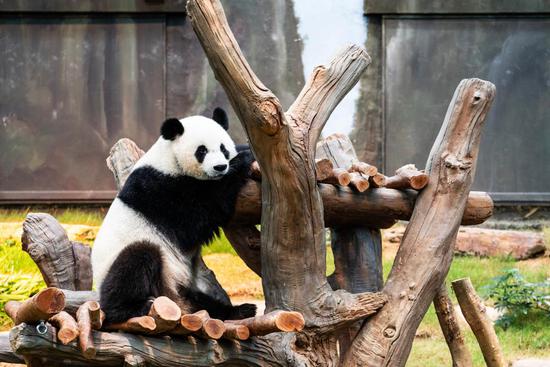Lunar, solar, Martian explorations among latest moves as State, private sectors advance side by side
The first-ever samples retrieved from the moon's far side, an iconic feat achieved by China's most recent lunar expedition, Chang'e 6, were on display at the 15th China International Aviation and Aerospace Exhibition, which took place in Zhuhai, Guangdong province, from Nov 12 to 17.
This was the first time the valuable lunar substances had been shown to the public since they were brought back to Earth in June.
The Chang'e 6 mission, representing the world's first attempt to bring back samples from the far side of the moon, was launched on May 3 from the Wenchang Space Launch Center in Hainan province.
After a series of complex maneuvers, the lander of the Chang'e 6 probe touched down at the South Pole-Aitken Basin on the lunar far side on June 2, and then began to collect surface and underground samples.
It was the second-ever landing of a spacecraft on the lunar far side. The vast region had never been reached by any spacecraft until January 2019, when the Chang'e 4 probe landed in the South Pole-Aitken Basin. Chang'e 4 surveyed areas surrounding its landing site, but did not collect samples.
The lander worked for 49 hours on the far side, using a mechanical arm and a drill to collect surface and underground materials.
The unmanned mission successfully concluded on June 25 with a total of 1,935.3 grams of samples from the far side retrieved.
The samples have unique scientific value and will further expand knowledge about the moon's history and help to gear up the exploration and exploitation of lunar resources, according to the China National Space Administration.
Previously, 10 lunar sample-return missions were undertaken by the United States, the former Soviet Union and China, but all these samples were collected from the moon's near side.
Before Chang'e 6, China had fulfilled a lunar sample-return mission — the Chang'e 5 in the winter of 2020, which landed on the moon's near side and recovered 1,731 grams of samples, the first lunar substances obtained since the Apollo era. It made China the third nation, after the US and the former Soviet Union, to have retrieved lunar samples.
So far, Chang'e 5 samples have enabled Chinese researchers to make a number of academic advancements, including the discovery of the sixth new lunar mineral, named Changesite-(Y).
Changesite-(Y), which falls in the category of lunar merrillite, is the first lunar mineral discovered and identified by Chinese scientists.
So far, China has conducted six robotic missions to explore the moon.
Besides the sample-collection endeavors, China has also deployed two rovers on the moon through the Chang'e 3 and Chang'e 4 missions.
The Yutu 2 rover, the central part of the Chang'e 4 mission, has worked on the moon for nearly six years, far exceeding its designed life of three months, and has traveled more than 1,600 meters, continuing to extend its lead as the longest-working robot on the moon.
In the coming years, China plans to continue to send unmanned probes to the moon and use the next two missions — Chang'e 7 and Chang'e 8 — to establish a prototype for the International Lunar Research Station, an ambitious multinational science project initiated by China.


















































 京公网安备 11010202009201号
京公网安备 11010202009201号